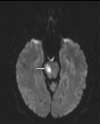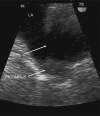Transesophageal Echocardiographically-Confirmed Pulmonary Vein Thrombosis in Association with Posterior Circulation Infarction
- PMID: 20689631
- PMCID: PMC2914368
- DOI: 10.1159/000313599
Transesophageal Echocardiographically-Confirmed Pulmonary Vein Thrombosis in Association with Posterior Circulation Infarction
Abstract
Pulmonary venous thromboembolism has only been identified as a cause of stroke with pulmonary arteriovenous malformations/fistulae, pulmonary neoplasia, transplantation or lobectomy, and following percutaneous radiofrequency ablation of pulmonary vein ostia in patients with atrial fibrillation. A 59-year-old man presented with a posterior circulation ischemic stroke. 'Unheralded' pulmonary vein thrombosis was identified on transesophageal echocardiography as the likely etiology. He had no further cerebrovascular events after intensifying antithrombotic therapy. Twenty-eight months after initial presentation, he was diagnosed with metastatic pancreatic adenocarcinoma and died 3 months later. This report illustrates the importance of doing transesophageal echocardiography in presumed 'cardioembolic' stroke, and that potential 'pulmonary venous thromboembolic' stroke may occur in patients without traditional risk factors for venous thromboembolism. Consideration should be given to screening such patients for occult malignancy.
Figures



References
-
- Schwalm S, Ward RP, Spencer KT. Transient ischemic attack in a patient with pulmonary vein thrombosis after left upper lobectomy for squamous cell lung cancer. J Am Soc Echocardiogr. 2004;17:487–488. - PubMed
-
- Nagahiro I, Horton M, Wilson M, Bennetts J, Spratt P, Glanville AR. Pulmonary vein thrombosis treated successfully by thrombectomy after bilateral sequential lung transplantation: report of a case. Surg Today. 2003;33:282–284. - PubMed
-
- Reilly MP, Plappert TJ, Wiegers SE. Cerebrovascular emboli related to pulmonary venous thrombosis after lung transplantation. J Am Soc Echocardiogr. 1998;11:299–302. - PubMed
-
- Ghaye B, Szapiro D, Dacher JN, Rodriguez LM, Timmermans C, Devillers D, Dondelinger RF. Percutaneous ablation for atrial fibrillation: the role of cross-sectional imaging. Radiographics. 2003;23(Spec No):S19–S33. - PubMed
Publication types
LinkOut - more resources
Full Text Sources

